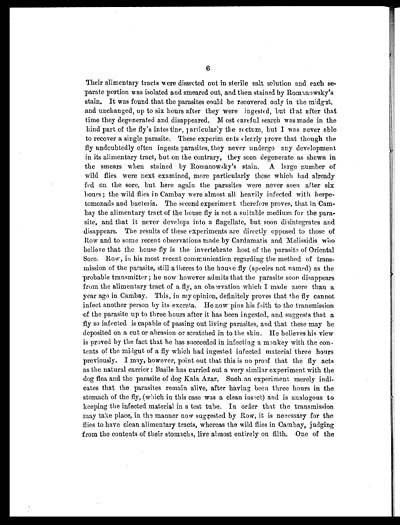Medicine - Institutions > Army health reports and medical documents > Scientific memoirs by officers of the Medical and Sanitary Departments of the Government of India > Number 50 - Preliminary report on an investigation into the etiology of Oriental sore in Cambay > Preliminary report on an investigation into the etiology of Oriental sore in Cambay
(16) Page 6
Download files
Individual page:
Thumbnail gallery: Grid view | List view

6
Their alimentary tracts were dissected out in sterile salt solution and each se-
parate portion was isolated and smeared out, and then stained by Romanowsky's
stain. It was found that the parasites could be recovered only in the midgut,
and unchanged, up to six hours after they were ingested, but that after that
time they degenerated and disappeared. Most careful search was made in the
hind part of the fly's intestine, particularly the rectum, but I was never able
to recover a single parasite. These experim ents clearly prove that though the
fly undoubtedly often ingests parasites, they never undergo any development
in its alimentary tract, but on the contrary, they soon degenerate as shewn in
the smears when stained by Romanowsky's stain. A large number of
wild flies were next examined, more particularly those which had already
fed on the sore, but here again the parasites were never seen after six
hours; the wild flies in Cambay were almost all heavily infected with herpe-
tomonads and bacteria. The second experiment therefore proves, that in Cam-
bay the alimentary tract of the house fly is not a suitable medium for the para-
site, and that it never develops into a flagellate, but soon disintegrates and
disappears. The results of these experiments are directly opposed to those of
Row and to some recent observations made by Cardamatis and Melissidis who
believe that the house fly is the invertebrate host of the parasite of Oriental
Sore. Row, in his most recent communication regarding the method of trans-
mission of the parasite, still a theres to the house fly (species not named) as the
probable transmitter; he now however admits that the parasite soon disappears
from the alimentary tract of a fly, an observation which I made more than a
year ago in Cambay. This, in my opinion, definitely proves that the fly cannot
infect another person by its excreta. He now pins his faith to the transmission
of the parasite up to three hours after it has been ingested, and suggests that a
fly so infected is capable of passing out living parasites, and that these may be
deposited on a cut or abrasion or scratched in to the skin. He believes his view
is proved by the fact that he has succeeded in infecting a monkey with the con-
tents of the midgut of a fly which had ingested infected material three hours
previously. I may, however, point out that this is no proof that the fly acts
as the natural carrier: Basile has carried out a very similar experiment with the
dog flea and the parasite of dog Kala Azar. Such an experiment merely indi-
cates that the parasites remain alive, after having been three hours in the
stomach of the fly, (which in this case was a clean insect) and is analogous to
keeping the infected material in a test tube. In order that the transmission
may take place, in. the manner now suggested by Row, it is necessary for the
flies to have clean alimentary tracts, whereas the wild flies in Cambay, judging
from the contents of their stomachs, live almost entirely on filth. One of the
Set display mode to: Large image | Zoom image | Transcription
Images and transcriptions on this page, including medium image downloads, may be used under the Creative Commons Attribution 4.0 International Licence unless otherwise stated. ![]()
| Permanent URL | https://digital.nls.uk/75061467 |
|---|
| Shelfmark | IP/QB.10 |
|---|---|
| Additional NLS resources: | |




